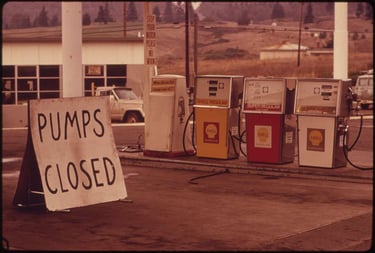From Crisis to Iron: Britain’s Battle with Inflation and the Rise of Thatcher
FRESH BREWS
In the 1970s, Britain was spiraling—strikes, soaring inflation, blackouts, and national frustration. Before Margaret Thatcher’s controversial rise to power, both Conservative and Labour governments failed to tame the economic chaos. This article unpacks the pivotal strikes, the oil shock, the Winter of Discontent, and how Thatcher's radical policies reshaped not just the economy, but the very soul of Britain.


Initially, I chose History as one of my A-Levels partly to avoid Economics. Numbers were never my strong suit, and the further away I was from it, the better. But when we began our topic on Britain from 1964 to 1990, it felt like I had accidentally chosen Economics after all. As the course progressed, however, I realised there’s no escaping economics as it truly shapes the world we live in.
So, as your barista today, I thought I’d serve you a history lesson albeit with a generous dose of Economics, of course. It is the EconCafe, after all.
But first, here are a few key terms that’ll make this story a bit smoother to sip on:
Inflation: This is the general increase in prices over time. When inflation rises faster than wages, people can afford less, meaning their real income falls even if their salary stays the same.
Trade Unions: These are groups of workers who band together to negotiate for better pay and working conditions. In this story, the National Union of Mineworkers (NUM) plays a major role.
Privatisation: Selling public sector services (owned by the government) to private companies.
Keynesianism vs Monetarism: Keynesian economics focuses on reducing unemployment by increasing government spending, while monetarism focuses on controlling inflation sometimes by cutting that same spending.
While Britain is often seen as a global superpower, by 1964 it was plagued by poverty, inflation, and rising unemployment. I’ll begin the story in 1972. By then, both Labour and Conservative governments had tried and failed to tackle inflation through policies like the 1965 Department of Economic Affairs, the 1967 devaluation, and the 1972 Barber Budget. Inflation hit 8.6%, and public frustration mounted. Before we reach for the Thatcher era lets go over three major strikes that set the stage for The Iron Lady.
The National Union of Mineworkers (NUM), representing underpaid coal miners, demanded a 47% wage increase.
And this conversation sums up the following..
In a nutshell:
Miners: We are not getting paid enough and demand a 47% increase right now.
Government: ..But that will just make inflation worse..! How about a 7.4% increase and we shake on it?
Miners: Uhh that is less than the current state of inflation so we still won’t be able to afford all that much. NO. We’re effectively taking a pay cut.
Government: Please..?
Miners strike, close down 289 mines and held coal hostage. Essentially blackmailing the government
Government: panicking Okay, a 20% increase final offer.
Miners: Kay!
Then came the 1973 oil crisis. In response to the Arab-Israeli War, Arab nations increased oil prices fivefold for Western countries. In Britain, inflation soared to 16% and unemployment to 1.44 million. Strikes intensified, unions exploiting the government's weakness to try for better wages. The government was so weakened that by 1974, it introduced a three-day working week because it just couldn’t keep the lights on. Schools and workplaces operated only half the week; the rest of the time, the country sat cold and in darkness. Now this was eventually settled in with a joint agreement called the Social Contract but by this time inflation had reached 27%, the highest since World War 2 and things were not looking good.
Skipping over a few critical moments though I recommend reading about the 1976 IMF bailout, an economic failure and remedy, we arrive at the infamous Winter of Discontent. Public frustration peaked. Frustration had mounted and the strikes flourished with the binmen, the grave diggers, transportation all coming to a halt. With rubbish out on the streets and the smell of corpses in the air, it was a national crisis.
Enter the Iron Lady. Margaret Thatcher. A controversial figure who began her campaign on the basis of stability and bringing Britain back to its former glory. With the tidal wave of change she was bringing, one of the key points in our area of focus was her switch from keynesianism to monetarist policies. This means that previous governments were using a Keynesian approach which meant they were targeting the reduction of unemployment. Now, Thatcher could see that this clearly was not working so her aim. through a monetarist approach, was to target the reduction of inflation. If she reduced inflation, then she could establish a stable economic environment that encouraged businesses to invest and expand, eventually creating more jobs. But it came at a cost.
In some ways, her goal was successful. By 1983, inflation had dropped from 27% to just 5% -a remarkable feat. Her government also sold off many state-owned enterprises, from British Airways to parts of the railway system, arguing that the private sector would run them more efficiently. Deregulation of the economy, especially in finance, helped make London a global financial hub again. If her goal was to stabilise the economy and make it globally competitive, she made incredible progress.
But the cost was steep. Unemployment soared to 3.5 million by 1985, an all-time high. When critics warned of the human consequences, she doubled down, supporting the idea that people should “get on their bike” and look for work. Communities that relied on mining and heavy industry, especially in the North, were devastated. Whole towns lost their core industries. The 1984-85 miners' strike was a desperate last attempt to push back, but Thatcher’s government was prepared and this time, force was used to shut it down. It marked not just the end of the strike, but a broader shift in power away from unions. There are two ways to look at the situation, as a successful method of preventing the nation wide chaos inflicted by workers for the past two decades or as a refusal to aid or sympathise with poorer communities who were forced to strike in order to be heard. These areas often still feel the effects of the closing of mines and largely blame Margaret Thatcher for their situation. Thus Thatcher remains a controversial figure for a reason. She tamed inflation and helped shift Britain into a more modern, free-market economy. But she also oversaw an era of deep social division, where economic recovery came at the expense of millions.
The question isn’t just whether her policies worked -but who they worked for. That's the thing about economics, whether we like it or not, it directly impacts us. And its solution never seems to be simple, the answer can look wholly different at the time to how it does in hindsight…
